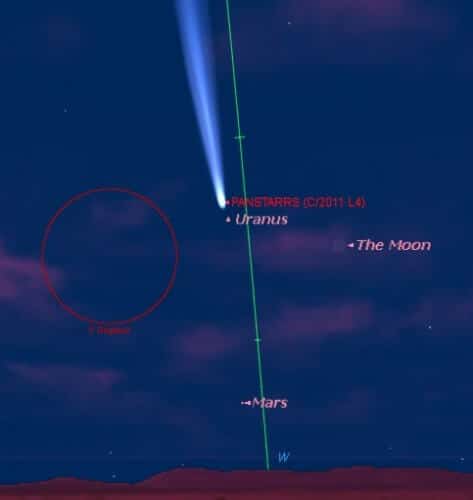The first of three bright comets expected to appear in 2013 - Fanstars, began to be visible with the naked eye to the residents of the southern USA this weekend, and today it will also be visible in the northern USA and Israel (latitude 30 north and above). It will be visible low in the western sky just after sunset

According to reports from more southern countries, Comet C/2011 L4 PanSTARRS was briefly visible just after sunset in the southwestern sky. According to the NASA website, it is expected today (March 12) to rise to the north and be visible to the naked eye, although still in the sunset sky even for residents in more northern areas.
Comet Fanstars reached its closest point to the Sun on March 10.
Viewers in the Southern Hemisphere have been enjoying the comet for several weeks now as it reached magnitude 6 around the end of February and began its long journey north.
The comet Fanstars orbits the sun in an orbit that is over 160 thousand years long in an orbit almost perpendicular to that of the Melaka plane (84.2 degrees). This means that it is actually at celestial latitude zero, the line where the sun will be on the equinox on March 20) and it is slowly gaining height in the following evenings.
Viewers in Hawaii and Mexico began seeing fanstars last week, and reports of sightings in the southern US also began Saturday night (March 9).
Meanwhile it is a body that looks like a normal star with a small fan-like tail. From a report by the writer of this article - David Atkinson of Universe Today as of the weekend in Florida, it could only be viewed with binoculars.

7 תגובות
Even today, March 13, the comet will not be observed without instruments. I watched 35 minutes after sunset to 60 minutes after sunset. During viewing, heavy fog over the sea on the west side and light cloudiness in addition.
All this in the hope that the clouds of dust from the Sahara will disperse, or sink, or fly to another place.
Unfortunately the sky in the Tel Aviv area was cloudy and I could not see anything. I will try tomorrow.
my father
Correction: today, the observation day, is March 12.
Today, March 11, we probably won't watch without devices.
Today I watched the time period between 35 minutes and 60 minutes after sunset to the place where it was supposed to show. I did not see anything.
According to what I understood - an hour ceiling.
Will it still be possible to see it a few hours after sunset?